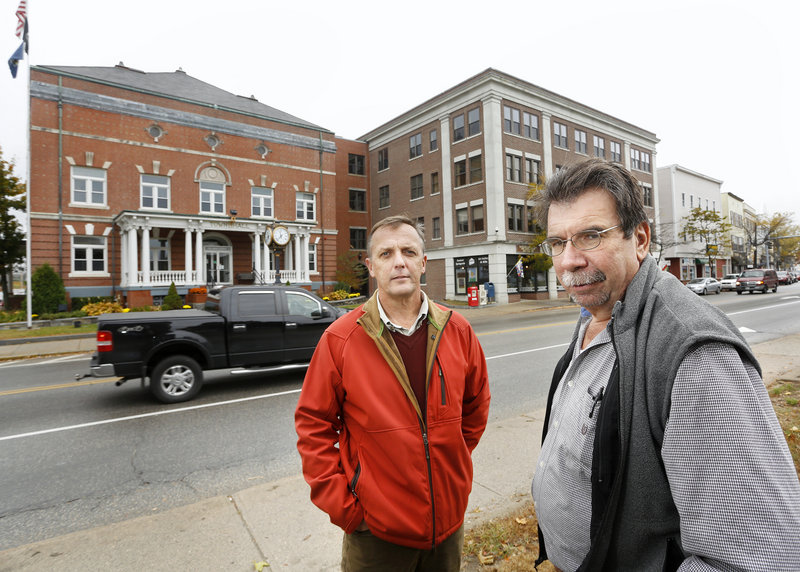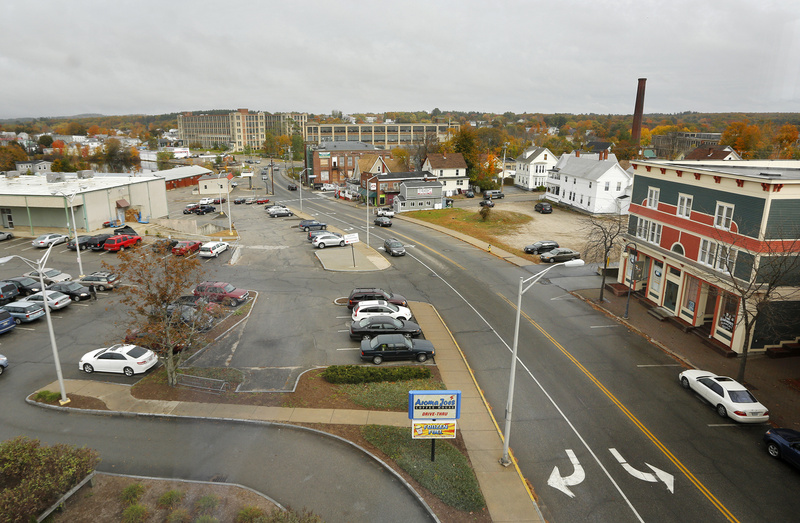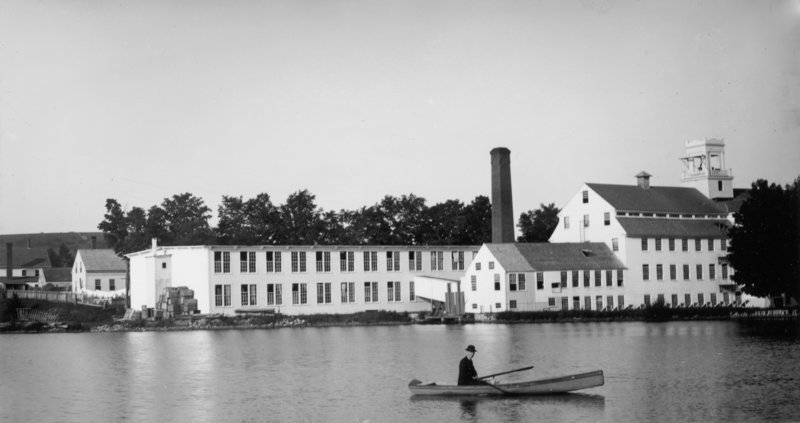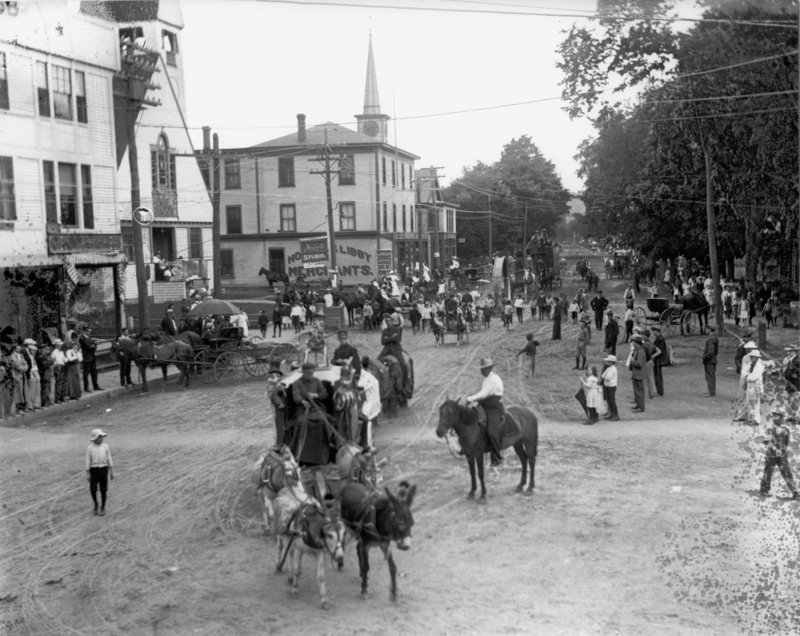SANFORD — The town that refused to die is at a crossroads.
Once described as such for its resilience in the face of textile mill closures, the town of Sanford now is poised to become a city.
Residents vote Nov. 6 on a proposal that would change its designation to a city, create a mayor’s position and eliminate the representative town meeting held annually since 1935.
Sanford, at the heart of York County, is the state’s largest town, with about 22,000 people. Built along the Mousam River, it has 10 miles of retail space stretching from south Sanford to the village of Springvale, a hospital, an airport, a large residential base and brick mills being redeveloped for commercial and residential uses.
Supporters of the change say the town is ready for further economic development.
But it needs to change its image.
“The problem is we don’t get looked at by the outside world,” said Brad Littlefield, a town councilor who served on the commission that spent 18 months developing the proposed charter. “We have the infrastructure of a city. We have the labor of a city. We have the schools of a city. What we don’t have is the municipal government of a city.”
Now is the time to capitalize on what Sanford has to offer by recognizing it for what it is, Littlefield said.
Others aren’t sure that being a city would really accomplish anything.
“Businesses won’t flock here just because we’re called a city,” resident Tom Cote said last week at a Town Council meeting.
If Sanford does become a city, it would be the first Maine community to do so since Caribou in 1967. The city of Sanford would be the seventh largest in the state in population, placing it ahead of Augusta and behind Biddeford.
Six years ago, more than half of Sanford residents voted to change to a city when the population reaches 30,000. The smallest city in the state is Eastport, population 1,331.
WHAT’S IN A NAME?
There are residents of Sanford and Springvale, especially lifelong ones, who feel there is a lot to be said for being part of a town.
Jim Drummey, a Springvale businessman, opened his first store in Sanford 30 years ago.
“I did it because of the small-town atmosphere where people know each other. In a city you lose a lot of that,” he said. “Right now we don’t really capitalize on this, but we are the largest town in Maine. Maybe we ought to do that. It sounds more friendly, whereas a city is big and impersonal.”
Alberta Sevigny, a lifelong resident, is worried that the new charter might change the village atmosphere of Springvale.
“I want to save the identity of Springvale,” she said. “It has historical value.”
The history of Sanford-Springvale dates to 1739, when the area was first settled and used for agriculture. In 1768, Massachusetts granted a charter to incorporate Sanford as a town. Agriculture continued to be the focus for years, until the first manufacturing industry — the printing of designs on cotton fabric — began in town in 1829. Soon, a textile mill was built in Springvale and was followed in the 1840s by the arrival of shoe manufacturing, said Town Historian Harland Eastman.
As the mills grew, so did the town.
In 1887, there were 2,700 residents; 23 years later, the population hit 9,000. A third of residents worked in the mills, manufacturing fabric for upholstery, blankets and suits. Over time, Sanford eclipsed Springvale as the industrial center of the community as the Goodall family built mills near downtown Sanford, Eastman said.
Things were going well until 1954, when Burlington Mills took over the Sanford Mills and began shipping looms to its Southern facilities.
“In the fall of 1954, the mills were locked and some 3,000 people were out of work overnight,” Eastman said. “That was the end of the Goodall Mills.”
As in other manufacturing communities in Maine, the closure of the mills hit hard, said state historian Earle Shettleworth.
“It challenged these communities to diversify, to find new industries and, ultimately, find new uses for the old mill buildings that had been left empty by the departure of the mill industry,” Shettleworth said.
After the Goodall Mills closed, local business owners traveled the region to entice businesses to come to Sanford, leading Life Magazine to dub it “the town that refused to die.” In the six decades that followed, manufacturing jobs came and went, and Sanford increasingly became a service center for surrounding towns. Sanford does not have direct access to the Maine Turnpike, but it is 90 miles from Boston, which many in town see as a selling point.
Jonathan Mapes, vice chairman of the Charter Commission and a local businessman, said Sanford now has the amenities of a city and should market itself better. Becoming a city and electing a mayor to lead the council will improve the public perception of Sanford and position it for economic growth, he said.
The mayor would replace the current Town Council chairman position and be afforded the same salary.
But Mapes recognizes the word “city” is the tallest hurdle to getting the charter approved by voters.
“That may be our greatest challenge when really it’s superficial. It’s emotional,” he said. “It’s my belief that having an elected mayor adds a little economic horsepower, a little vibrancy to our community. It’s hard to quantify why a city. It’s a simple personality improvement.”
TOWN MEETING TRADITION
If enacted, the charter would eliminate the representative town meeting, which Charter Commission members said will streamline government and allow all residents to vote annually on both the municipal and school budgets.
Sanford has the only representative town meeting in the state. Unlike town meetings held in other towns where all voters can participate, Sanford participants are elected to represent voters in the town’s seven wards.
The new charter also would eliminate the nine-member Finance Committee and replace it with a seven-member Budget Committee appointed by the council.
Currently, the Finance Committee reviews the budget and sends it to the town meeting. During the meeting, elected and appointed representatives further review, adjust and approve the budget.
This year, 68 representatives approved the $50 million budget and a 10 percent tax increase.
There are supposed to be 105 representatives at the town meeting, but it has become increasingly hard to get people to participate. When the charter was revised in 2002, it dropped the number of representatives from 140 because of low interest.
The last time there was a competitive race for the Finance Committee was in the late 1970s, Littlefield said. He speculates the decline can be attributed to residents living busy lives and commuting longer distances.
Rick Stanley, president of the Sanford-Springvale Chamber of Commerce and a lifelong Springvale resident, has noticed the shift to more residents working outside Sanford.
“When I was young, you knew most of the people in your neighborhood who had lived here pretty much their whole lives. I think the mobility of the work force has changed that and turned Sanford into a bedroom community,” he said. “People will live here because the cost of housing is less, then work in Portland, Portsmouth or even Boston.”
Drummey, a longtime Finance Committee member, believes the Finance Committee and town meeting are an important check and balance in town government. He wishes more people would take an interest, but recognizes “there’s a terrible apathy, not only here in this town, but around the United States,” he said.
“I’m a firm believer in people’s rights to know and to vote and to be able to have their say in their own future. I’m afraid we’re going to lose that,” he said.
Margaret Trowbridge, a Charter Commission member who opposes the proposed changes, said she does not feel the Finance Committee or town meeting process is broken, as do some other commission members.
“Town meeting is the only time people have a chance to voice their opinion on the budget,” she said. “It’s like taking freedom of speech from the people in the community.”
Cote, the resident who spoke at a pubic hearing on the proposed charter, said he is concerned the change in the budget process will end a line-by-line review of the budget.
Bill Underwood of Springvale said at the public hearing he likes the idea of approving the budget by referendum.
“I was surprised to learn the recent 10 percent tax increase was approved by only 68 people,” he said. “That’s way too much taxing authority given to a small group.”
Littlefield said the new charter would allow more residents to become involved in the budget process through public hearings and the referendum.
“Every citizen in Sanford gets to vote on whether their taxes are going to be raised,” he said. “That’s democracy. That’s representation. That’s participation.”
TIME FOR ROAD WORK
Everyone in town seems to agree something needs to be done to fix roads after years of no improvements. The way to do that is to guarantee there will be money available each year to invest in roads and sidewalks, according to the Charter Commission.
For that, the proposed charter slowly increases the annual allocation for the Capital Improvement Plan from 2 percent of the previous year’s budget to 4 percent. This year’s budget included an additional $1 million to fix roads in town, 3.9 percent of the previous year’s budget.
Drummey, who is not entirely opposed to the proposed charter, said he is concerned about the mandated increase in the CIP because he feels it will lead to tax increases.
“I wouldn’t want to be forced to do it. I want the choice,” he said.
Mapes disagrees.
“The CIP all by itself does not increase taxes. It just doesn’t,” he said, noting savings could be found in other areas of the budget to offset the increase.
Charter Commission members said it has been difficult to engage residents in the charter review process. Chairman Bob Stackpole last week told town councilors that fewer than five residents attended commission meetings in 18 months.
Seven residents — including Stackpole and Mapes — commented during the public hearing Tuesday night at Sanford Town Hall.
Mapes and Littlefield are on a ballot question committee formed to raise money and put up signs around town encouraging people to approve the charter. There is no similar organized effort by opponents of the charter.
Several former commission members, including Mapes and Littlefield, have met with community groups to summarize the charter and answer questions. They found many people had heard about the proposed changes but had not actually read the charter.
At the council meeting, Stackpole encouraged residents to read the charter, or at least review the summary of changes written by the commission and distributed throughout town.
Staff Writer Gillian Graham can be contacted at 791-6315 or at:
ggraham@mainetoday.com
Twitter: grahamgillian
Copy the Story Link
Send questions/comments to the editors.







Success. Please wait for the page to reload. If the page does not reload within 5 seconds, please refresh the page.
Enter your email and password to access comments.
Hi, to comment on stories you must . This profile is in addition to your subscription and website login.
Already have a commenting profile? .
Invalid username/password.
Please check your email to confirm and complete your registration.
Only subscribers are eligible to post comments. Please subscribe or login first for digital access. Here’s why.
Use the form below to reset your password. When you've submitted your account email, we will send an email with a reset code.